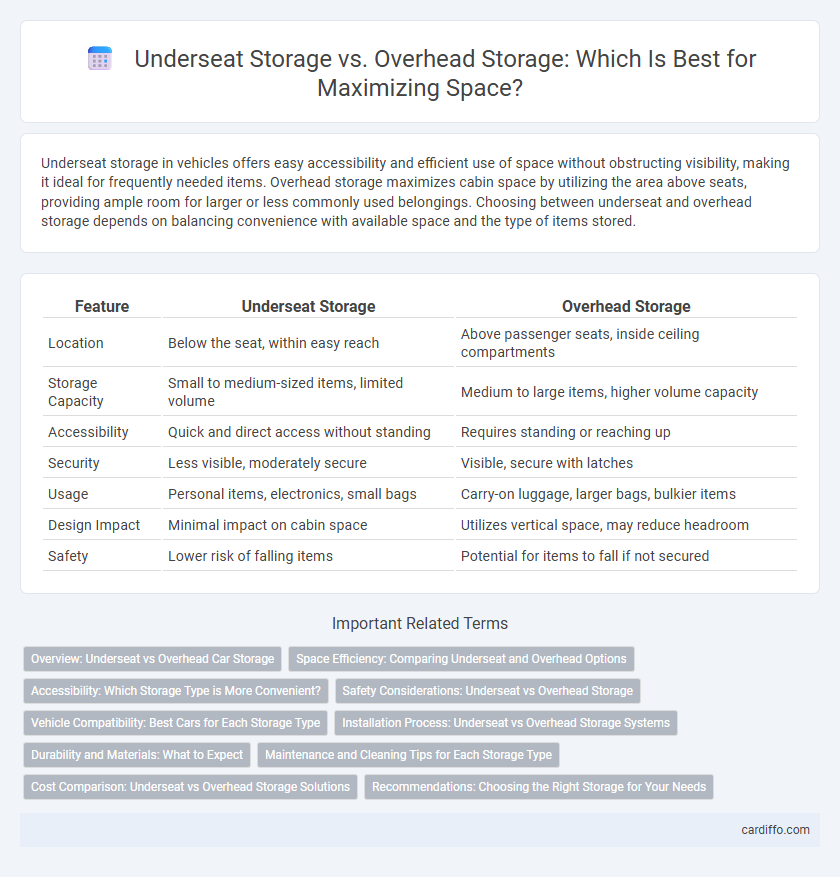Underseat storage in vehicles offers easy accessibility and efficient use of space without obstructing visibility, making it ideal for frequently needed items. Overhead storage maximizes cabin space by utilizing the area above seats, providing ample room for larger or less commonly used belongings. Choosing between underseat and overhead storage depends on balancing convenience with available space and the type of items stored.
Table of Comparison
| Feature | Underseat Storage | Overhead Storage |
|---|---|---|
| Location | Below the seat, within easy reach | Above passenger seats, inside ceiling compartments |
| Storage Capacity | Small to medium-sized items, limited volume | Medium to large items, higher volume capacity |
| Accessibility | Quick and direct access without standing | Requires standing or reaching up |
| Security | Less visible, moderately secure | Visible, secure with latches |
| Usage | Personal items, electronics, small bags | Carry-on luggage, larger bags, bulkier items |
| Design Impact | Minimal impact on cabin space | Utilizes vertical space, may reduce headroom |
| Safety | Lower risk of falling items | Potential for items to fall if not secured |
Overview: Underseat vs Overhead Car Storage
Underseat storage offers easy access and secure space for smaller items like bags and electronic devices, making it ideal for drivers and passengers who need quick retrieval. Overhead storage provides larger capacity and visibility for bulky or infrequently used items, enhancing cabin organization without compromising legroom. Choosing between underseat and overhead car storage depends on vehicle size, item type, and usage frequency.
Space Efficiency: Comparing Underseat and Overhead Options
Underseat storage maximizes space efficiency by utilizing often overlooked areas beneath seats, offering easy access without compromising cabin headroom or visibility. Overhead storage compartments provide higher volume capacity but can limit passenger movement and reduce vertical space, particularly in compact environments like airplanes or vehicles. Choosing between underseat and overhead storage depends on balancing accessible space with overall spatial constraints to optimize storage solutions.
Accessibility: Which Storage Type is More Convenient?
Underseat storage offers superior accessibility by allowing quick and easy reach to items without the need to stand or stretch, making it highly convenient during travel or daily use. Overhead storage, while providing ample space, often requires lifting items above head height, which can be less convenient and slower to access, especially for shorter individuals or when the vehicle is in motion. For seamless and immediate access, underseat storage is generally the more practical choice.
Safety Considerations: Underseat vs Overhead Storage
Underseat storage reduces the risk of falling objects during sudden stops, enhancing passenger safety by keeping items securely contained at ground level. Overhead storage requires robust latching mechanisms to prevent luggage from shifting or falling, which could cause injuries in turbulence or abrupt movements. Choosing underseat storage minimizes head injury hazards and ensures easier access without standing, improving overall safety for passengers in transit.
Vehicle Compatibility: Best Cars for Each Storage Type
Underseat storage is ideal for compact cars and SUVs such as the Honda CR-V and Toyota RAV4, where limited cabin space benefits from hidden compartments that optimize interior organization. Overhead storage suits larger vehicles including vans and trucks like the Ford Transit and Mercedes-Benz Sprinter, offering ample space without encroaching on passenger legroom. Matching storage solutions to vehicle type enhances usability and maximizes cargo capacity efficiently.
Installation Process: Underseat vs Overhead Storage Systems
Underseat storage systems typically feature a simpler installation process, often requiring minimal tools and fewer mounting points due to their compact size and location beneath seats. Overhead storage systems demand more complex installation, involving secure anchoring to ceiling structures and careful weight distribution to ensure safety and stability. Choosing between these systems depends on the vehicle's design, with underseat storage offering easier integration and overhead units providing greater capacity but requiring professional installation.
Durability and Materials: What to Expect
Underseat storage typically features robust materials such as reinforced plastic or metal frames designed to withstand frequent handling and weight stress, ensuring long-term durability. Overhead storage compartments often utilize lighter composites or aluminum alloys to balance structural integrity with weight constraints, prioritizing strength without adding excessive load. Expect underseat storage to offer more resilience against impact and daily wear, while overhead storage materials focus on rigidity and safe weight distribution for cabin safety.
Maintenance and Cleaning Tips for Each Storage Type
Underseat storage requires regular vacuuming to remove dust and debris, and wiping with a damp cloth to prevent mold or mildew buildup in enclosed spaces. Overhead storage compartments benefit from periodic dusting with microfiber cloths and inspection for loose fixtures to ensure safety and cleanliness. Using mild cleaning agents suitable for interior surfaces helps maintain durability and appearance for both storage types.
Cost Comparison: Underseat vs Overhead Storage Solutions
Underseat storage solutions generally offer a more cost-effective option compared to overhead storage due to lower material and installation expenses. Overhead storage often requires reinforced support structures and specialized mounting hardware, increasing overall project costs. Budget-conscious buyers typically favor underseat storage for its affordability and efficient use of space.
Recommendations: Choosing the Right Storage for Your Needs
Underseat storage offers easy access and is ideal for frequently used items, while overhead storage maximizes space for larger or less frequently needed belongings. When selecting the right storage, consider the type and size of items, accessibility requirements, and available cabin space. Prioritize underseat compartments for convenience and overhead bins for bulkier cargo to optimize travel efficiency and comfort.
Underseat storage vs overhead storage Infographic

 cardiffo.com
cardiffo.com